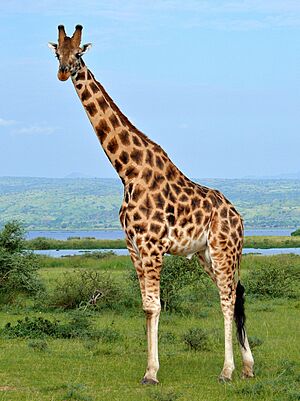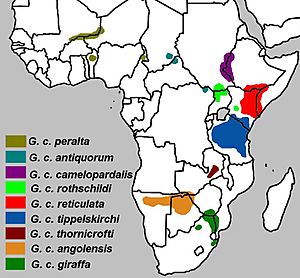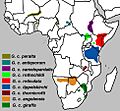Rothschild's giraffe facts for kids
Quick facts for kids Rothschild's giraffe |
|
|---|---|
 |
|
| A male Rothschild's giraffe at Murchison Falls National Park, Uganda | |
| Conservation status | |
| Scientific classification |
|
| Kingdom: | Animalia |
| Phylum: | Chordata |
| Class: | Mammalia |
| Order: | Artiodactyla |
| Family: | Giraffidae |
| Genus: | Giraffa |
| Species: | |
| Subspecies: |
G. c. rothschildi
|
| Trinomial name | |
| Giraffa camelopardalis rothschildi Lydekker, 1903
|
|
 |
|
| Rothschild's giraffe's range in light green | |
| Synonyms | |
|
G.c. rothschildi (Lydekker, 1903) |
|
The Rothschild's giraffe (Giraffa camelopardalis rothschildi) is a special type of Nubian giraffe. It is one of the most endangered kinds of giraffe. In 2018, only about 1,399 adult Rothschild's giraffes were left in the wild.
Contents
About Rothschild's Giraffe
The IUCN is a group that studies nature. They currently say there is only one species of giraffe with nine different types, called subspecies. The Rothschild's giraffe is named after Walter Rothschild. He was the founder of the Tring Museum.
This giraffe is also known by other names. People sometimes call it the Baringo giraffe. This name comes from the Lake Baringo area in Kenya. It is also known as the Ugandan giraffe. All Rothschild's giraffes living in the wild today are found in protected areas. These areas are in Kenya and Uganda.
Scientists have studied how giraffes are related. In 2007, some thought the Rothschild's giraffe should be its own species. Later, in 2016, others suggested it was the same species as the Nubian giraffe. However, not everyone agrees on this idea yet.
What Makes Them Special?
Rothschild's giraffes are easy to tell apart from other giraffes. Look at the patterns on their coats. The reticulated giraffe has very clear, dark patches. These patches have bright white lines between them.
The Rothschild's giraffe looks more like the Masai giraffe. But the Rothschild's giraffe is usually paler. Its orange-brown patches are less jagged. The lines connecting the patches are a creamy color. This is different from the white lines on the reticulated giraffe.
Another cool thing about Rothschild's giraffes is their legs. They have no markings on their lower legs. This makes it look like they are wearing white stockings!
Unique Features
Rothschild's giraffes have a special feature on their heads. They are the only type of giraffe born with five ossicones. Ossicones are horn-like growths on their heads. All giraffes have two large ossicones on top of their heads.
Rothschild's giraffes have three more. One ossicone is often in the middle of their forehead. The other two are behind each ear. These giraffes are also very tall. They can grow up to 5.88 meters (about 19 feet) tall. They can weigh up to 2,500 pounds.
Male Rothschild's giraffes are bigger than females. They can weigh a few hundred pounds more. Their two largest ossicones often become bald. This happens from sparring, which is like playful fighting. Males also tend to be darker in color. But this is not always a sure way to tell if a giraffe is male or female.
Where They Live
Rothschild's giraffes live in separate groups. You can find them in savannahs, grasslands, and open woodlands. These areas are in Uganda and Kenya. They might have disappeared from South Sudan and the northeastern part of the Democratic Republic of the Congo.
Life and Behavior
Rothschild's giraffes can mate at any time of the year. A female giraffe carries her baby for 14 to 16 months. She usually gives birth to one calf. They live in small herds. Males and females usually live separately. They only come together to mate.
These giraffes are generally friendly. They are okay with other animals around them. This is true as long as they do not feel threatened. Males are known to fight each other for mating rights. Since they can mate all year, these battles happen often.
Threats and Conservation Efforts
In 2018, the Rothschild's giraffe was listed as near threatened. This means they are close to becoming endangered. There are very few places left where you can see them in the wild. Some important places are Lake Nakuru National Park in Kenya. Another is Murchison Falls National Park in northern Uganda.
Their natural predators include hyenas, lions, crocodiles, and leopards.
Scientists have seen two dwarf giraffes in Murchison Falls National Park. These giraffes were only about 9.5 feet tall. Scientists think their small size might be due to inbreeding. This can happen when there are very few giraffes left.
Helping Rothschild's Giraffes
Many zoos have special breeding programs. One famous place is the Giraffe Centre in Nairobi, Kenya. These programs help increase the number of Rothschild's giraffes. They also help keep their gene pool healthy.
As of January 2011, over 450 Rothschild's giraffes lived in zoos. These zoos are registered with the ISIS. This system tracks animals in zoos worldwide. The Rothschild's giraffe is one of the most common types of giraffe in zoos.
Images for kids






